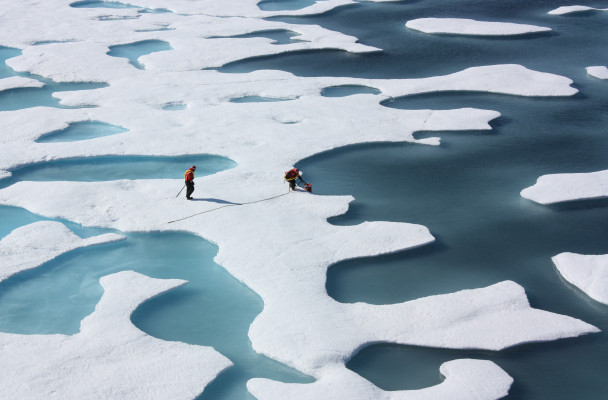
Chemistry of the Arctic Pacific Environment.” (photo by Kathryn Hansen/NASA)
Still melting, and melting fast: that’s the basic take-away from the federal government’s annual Arctic Report Card, released Tuesday.
The report, from the National Oceanic and Atmospheric Administration (NOAA), finds that Arctic ocean temperatures are increasing and sea ice is declining at the fastest rate in at least 1,500 years.
The report’s subtitle says it all: “Arctic shows no sign of returning to reliably frozen region of recent past decades.”
Instead, everything is warming: ocean temperatures, air temperatures, permafrost temperatures. Sea ice is shrinking, the tundra is greening, and it’s all happening at a stunning pace. So fast, in fact, that researchers presenting the report kept returning to one word: “unprecedented.”
Jeremy Mathis, with NOAA’s Arctic Research Program put it most succinctly. The Arctic, he said, is now going through “the most unprecedented transition in human history” – and that should concern everyone.
“We want every single American to know the changes happening in the Arctic will not stay in the Arctic,” Mathis said. “These changes will impact all of our lives.”
Mathis compared the Arctic to the planet’s refrigerator.
“But the door to that refrigerator has been left open,” he said. “And the cold is spilling out, cascading throughout the Northern Hemisphere.”
Impacts outside the region include ripple effects from the melting Greenland ice sheet, a major driver of sea level rise. And researchers increasingly believe that a warming Arctic is contributing to more extreme weather events across North America, though the mechanism isn’t well understood.
One of the more eye-popping statistics came from NOAA’s Emily Osborne. She reported on a review analyzing things like lake sediments and ice cores to reconstruct the past.
“This data set shows that the magnitude and sustained rate of warming and sea ice decline is unprecedented over the last 1,500 years and likely longer,” Osborne said.
Then Vladimir Romanovsky, a permafrost researcher at the University of Alaska, Fairbanks, reported that in 2016, observational sites across the Arctic reported their highest permafrost temperatures on record.
Mathis said the rapid changes taking place in the Arctic now have a momentum of their own: the process called “Arctic amplification” or “Arctic darkening.” As bright sea ice, snow and glaciers are replaced by darker water and land, the Arctic reflects less heat and absorbs more, leading to more warming.
“That great service that the Arctic has done for the planet by reflecting that heat back into space, is now being absorbed and trapped in the environment,” Mathis said.
He added, that trend is only continuing.
